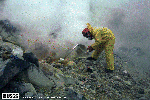
USGS/Cascades Volcano Observatory, Vancouver, Washington
Alaska Volcanoes -
Miscellaneous Images
- Augustine Island
- Katmai Vicinity and Novarupta
- Mount Mageik
- Mount Redoubt
- Mount Spurr
-
 [Image,35K,JPG]
[Image,35K,JPG]
Augustine Island Volcano.
-- USGS Photo by Harry Glicken, 1986
-
 [Image,38K,JPG]
[Image,38K,JPG]
View southeast of Augustine volcano, Alaska. At the
beginning of an eruption about 350 years ago the former
summit collapsed as a huge debris avalanche. The avalanche
swept to the sea, forming the hummocky deposit visible in
foreground. The great avalanche apparently initiated a
gigantic local tsunami that ravaged the shores of lower
Cook Inlet.
-- USGS Photo by Richard Waitt
-
 [Image,310K,GIF]
[Image,310K,GIF]
Vertical aerial view of north part of Augustine Island in
September 1991. At the beginning of the 1883 eruption a
large debris avalanche suddenly removed the volcano's
summit (just south of image) and slid to the sea, forming
the hummocky deposit on the coast. Light-colored materials
overlying the hummocky debris avalanche are deposits of
numerous hot (so-called "pyroclastic) flows from the dome
during eruptions in 1883, 1976, and 1986.
-
 [Image,240K,GIF]
[Image,240K,GIF]
Aerial oblique view east-northeast of Homer Spit, jutting
4 miles out into Kachemak bay in southern Cook Inlet.
Thousands of people flock to the spit daily in summer. The
highest part of the spit is only a few feet above high-
tide limit. The spit is thus vulnerable to a tsunami from
a future debris avalanche originating at Augustine volcano
70 miles away.
-
 [Image,290K,GIF]
[Image,290K,GIF]
View south of Augustine volcano. During the Winter-Spring
1986 eruption, hot pyroclastic flows melted snowpack and
caused small catastrophic floods that carried these large
boulders to the lower volcano flank and the sea.
-
 [Image,170K,GIF]
[Image,170K,GIF]
View south of Mount Augustine volcano, Alaska, in July 1990.
The low, hummocky, vegetated debris in right foreground is
the deposit of a great landslide (debris avalanche) at
beginning of the 1883 eruption that removed the summit.
After the avalanche five dome-building eruptions (1883,
1935, 1963-64, 1976, 1986) restored the summit ot its
former volume and steepness, setting the stage for a new
avalanche.
|
Katmai Vicinity and Novarupta
|
-
 [Image,64K,JPG]
[Image,64K,JPG]
Aerial view, Novarupta Dome, Katmai Vicinity, Alaska.
-- USGS Photo by Gene Iwatsubo, July 29, 1987
-
 [Image,72K,JPG]
[Image,72K,JPG]
Fumarole sampling, Mount Mageik
-- USGS Photo by Bea Ritchie, July 1995
-
 [Image,270K,GIF]
[Image,270K,GIF]
View south of Redoubt volcano, Alaska on 7 April 1990. Hot
pyroclastic flows during eruptions between December 1989
and June 1990 melted most of upper Drift glacier.
Resulting floods threatened an oil storage-and-loading
facility at the valley mouth. Debris of the pyroclastic
flows thickly mantled the piedmont lobe of the Drift
glacier (in foreground).
-
 [Image,230K,GIF]
[Image,230K,GIF]
View northwest of Redoubt volcano, Alaska, on 4 March
1990. Steam commonly vents from the dome in the crater in
between eruptions.
-
 [Image,305K,GIF]
[Image,305K,GIF]
View west of Redoubt volcano on 10 April 1990. Drift
glacier occupies the valley extending from the vent (at
steam plume) to the valley bottom (visible in lower
right).
-
 [Image,275K,GIF]
[Image,275K,GIF]
View southwest down Crescent glacier on south flank of Mt.
Redoubt volcano in August 1990. A hot pyroclastic surge
during the eruption of 15 December 1989 caused thick
snowpack near on the upper volcano flank to avalanche and
partly melt. The glacier in the right middleground is
blanketed (dark material at surface) by an an unusual ice
diamict emplaced during the eruption.
-
 [Image,488K,GIF]
[Image,488K,GIF]
Acoustic Flow Monitor (AFM) site in the Drift River valley, near Redoubt Volcano, Alaska. The key
component of the AFM system is a seismometer, buried in the ground nearby, that responds to the high-frequency (10-300
Hz) vibrations that characterize lahars.
Inspired by the Nevado del Ruiz tragedy in 1985,
the AFM system was developed
and tested at Mount Redoubt, and then successfully used
in the Philippines to monitor lahars at Mount Pinatubo.
-- USGS Photo by S. R. Brantley.
-
 [Image,255K,GIF]
[Image,255K,GIF]
View north of Crater Peak, the active vent of Mount Spurr,
Alaska, on 26 September 1992. Crater Peak erupted in June,
August, and September 1992. Ash from the August eruption
closed Anchorage International Airport. Behind the small
steam plume is Mount Spurr. Spurr and the peak visible
on the left define the rim of caldera, evacuated by a huge
debris avalanche about 10,000 years ago.
-
 [Image,380K,GIF]
[Image,380K,GIF]
View south of one of hundreds of impact craters on the
lower southeast flank of Crater Peak. This one is of a 1-m
(3-ft) ballistic block that landed 3.3 km (2.1 mi) from
the vent during 19 August 1992 eruption. The block
fragmented upon impact, parts of it lying downrange beyond
rim of impact crater. Many of these ballistics travelled
unusual horizontal arcs.
Return to:
[CVO Alaska Menu] ..
[CVO Volcano Photo Archives Menu] ...

Use of CVO Material and Copyright Information
URL for CVO HomePage is:
<http://vulcan.wr.usgs.gov/home.html>
URL for this page is:
<http://vulcan.wr.usgs.gov/Volcanoes/Alaska/images.html>
If you have questions or comments please contact:
<GS-CVO-WEB@usgs.gov>
03/25/02, Lyn Topinka
 Use of CVO Material and Copyright Information
Use of CVO Material and Copyright Information


 [Image,35K,JPG]
[Image,35K,JPG]
 [Image,38K,JPG]
[Image,38K,JPG]
 [Image,310K,GIF]
[Image,310K,GIF]
 [Image,240K,GIF]
[Image,240K,GIF]
 [Image,290K,GIF]
[Image,290K,GIF]
 [Image,170K,GIF]
[Image,170K,GIF]
 [Image,64K,JPG]
[Image,64K,JPG]
 [Image,72K,JPG]
[Image,72K,JPG]
 [Image,270K,GIF]
[Image,270K,GIF]
 [Image,230K,GIF]
[Image,230K,GIF]
 [Image,305K,GIF]
[Image,305K,GIF]
 [Image,275K,GIF]
[Image,275K,GIF]
 [Image,488K,GIF]
[Image,488K,GIF]
 [Image,255K,GIF]
[Image,255K,GIF]
 [Image,380K,GIF]
[Image,380K,GIF]
